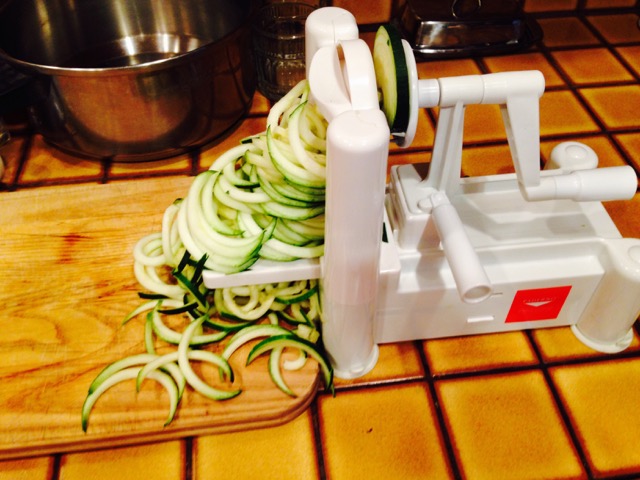 |
Spiralized sweet potato "fries" roasted at 425. Recipe below.
|
I rarely get so excited about a kitchen gadget that I promote it. I'm not saying that just because I'm smitten with the spiralizer, you should run right out and buy one. It took me a year to respond, with my credit card, to a friend who alerted me to this clever device that is now my second best friend in the kitchen, my bestie being my food processor,which happens to be a Cuisinart.
My friend even loaned me her spiralizer because she was certain that if I used it, I would rush forth with the plastic card. I admit I didn't even try the damn thing before returning it to her. Why? I was attempting to purge possessions, not accumulate them. Also, as I saw it, the spiralizer would hog a significant chunk of kitchen storage and be just another piece of plastic about which to feel guilt and remorse. So I returned it to my friend saying, thanks, but no thanks.
Then zucchini season reared up. As usual, I gave away or tossed into the compost an embarrassing poundage of zucchini flesh. (Somehow, we always have way too much zucchini, even when we limit ourselves to two or three plants.) Then I remembered the spiralizer, and in desperation, used Amazon Prime to have one delivered within a couple days. And then the fun began! The poor neighbors, and others upon whom I'd foisted excess produce, no longer had to feign enthusiasm for zucchini; I actually was able to use most of it. Yes. We ate a TON of zucchini, but as noodles, and somehow, that makes a difference.
 |
| Zucchini noodles quick frying in a little olive oil and salt. |
 |
The real pasta boils on the back burner as I test the zucchini noodles for "al dente" with a hand which appears to be on loan from a wax museum,
|
Obviously, the pasta swells and the zucchini shrinks. This is indicative of what happens when we eat pasta (swell) and when we eat zucchini (shrink.)
Zucchini was the obvious first choice for veggie noodles, but once the zucchini plants up and died, I moved on to potatoes, sweet potatoes, and beets. And according to food bloggers, I'm just getting started. For recipes and in-depth info, check out this blog and get a steady stream of recipes and ways to use the spiralizer. In addition to noodles, it can also slice veggies into thin rounds.
 |
| The sweet potato fries are great! Easy, tasty, nutritious. Here they are with a salmon patty sandwich and a green salad with avocado. Recipe below. |
For two hungry people
- 1 large sweet potato. Choose one that is relatively straight and about 3 to 3.5 inches in diameter.
- olive oil, about 2 tablespoons
- salt and pepper to taste
- pepper flakes, optional
Directions
Preheat the oven to 425.Spiralize the sweet potato. You will need to cut it to fit for spiralizing.
Snip the noodles into lengths of your choice, or not.(Some people love long curly fries, but they take longer to roast and may not cook as evenly as snipped noodles.)
Cover a large baking sheet with parchment paper. Spread the oiled noodles over the paper and salt and pepper to taste. Add pepper flakes if you like them. Roast for 10 to 12 minutes, then check for doneness. Use tongs to turn, and roast another 10 minutes, watching closely so they don't burn.
The sweet potatoes may also be fried, preferably in a cast-iron skillet. But this requires closer attention and more oil. However, the fries will be crunchier.
Ready to try a spiralizer? You can't go wrong.

























